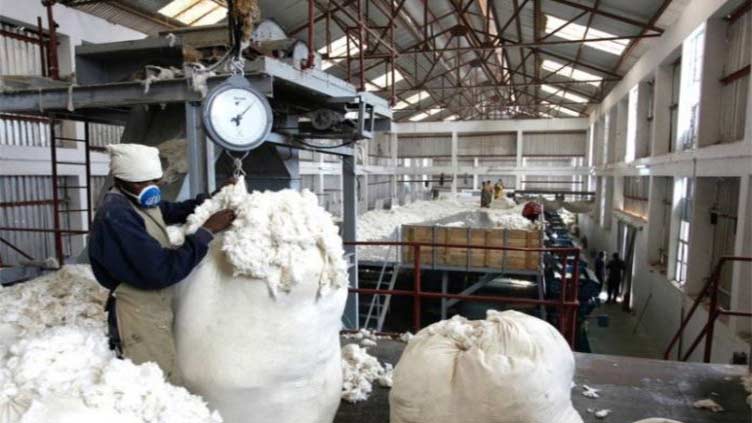Encouraging cotton growing helps excel textile industry'

Pakistan
A major chunk of our populace linked to agricultural sector.
FAISALABAD, (APP) - With the country faces severe economic crunch, the government is mulling multiple options for economic revival including boosting exports to strengthen depleting foreign exchange reserves and generate employment opportunities to overcome growing poverty.
As textile industry had been the key player in exports over the decades, paying special heed to this sector by providing congenial environment could pave the way to capture more international markets and earn revenue.
Enhanced cotton growing is of vital importance for this sector as it encompasses a bigger chain of operations from farming to textiles mills and then to end users’ products showcased at fashion apparel outlets.
This chain of operations not only benefits industrialists but also a major chunk of our populace linked to agricultural sector. But unfortunately, cotton growing diminished with the passage of time after installation of Sugar Mills in cotton growing areas, especially in South Punjab and Sindh provinces.
Pakistan Cotton Ginners Association (PCGA), in its recent fortnightly report on cotton arrivals has put the production figure at 4.7 million bales till Feb 1, 2023 that is almost 35 per cent below than last year.
“If we reach five million bales this year by end of next month, it would be around 50 per cent below than the official production assessment of 11 million bales for 2023”, informed PCGA Chairman Chaudhry Waheed Arshad.
“If we have to survive with our textile industry, we must frame result oriented policies focusing both the farmers and the industrialists,” he stated.
Chaudhry Waheed Arshad recommended measures like announcing support price, declaring specific cotton zones, introducing high yielding, climate smart and pests resistant cotton varieties and mechanized farming techniques to get desired results.
“Agriculture is our mainstay and cotton is our lifeline. Therefore, strengthening this sector and announcing special incentives for cotton growers would definitely improve economic growth and the country’s exports,” he stated.
Chaudhry Waheed said that less cotton growing was harming ginning industry because if produce is less then mill owners can import cotton for their needs but what about ginners. “There are 1300 ginning factories countrywide with only 400-500 units remaining operational normally. But, at present only 154 factories are working.”
He claimed that the country has lost 2.4 million acre cotton area to other crops during last 15 years and “if this trend continues, it would be a severe blow to the cotton-based industries. Therefore, we need to employ full potential of this sector.”
He was confident sooner or later agriculture sector would attain the status of an industry and farmers must be well prepared to harvest its benefits.
According to the Trade Development Authority of Pakistan (TDAP), Pakistan is the 8th largest exporter of textile products in Asia with 4th largest producer and third largest consumer of cotton. Textile is 46 percent of Pakistan’s total manufacturing sector that provides employment to 40 percent of total labor force.
Khawaja Usman, a noted industrialist owning spinning units has said that usually, textile sector needs 16 million cotton bales annually to add value and export a variety of products to international market.
“However, the temporary closure of some textile units due to the global recession troubled the economy.
Therefore, local textile sector requirements would revolve around 12-13 million bales this year,” he predicted.
He said if production finally turns out to be five million bales in 2023, textile sector would need to import seven million bales to meet its requirements. “Therefore, the textile sector had already finalized contracts for import of required cotton bales.”
Khawaja Usman stressed to incentivize the farmers to grow cotton on more area, and the industry to enable it to compete in international market as he regretted that falling of cotton production by 16 percent to merely 8.6 million bales in 2020 from 10.2 million bales in 2019, is not encouraging.
The TDAP officials quoting Pakistan Bureau of Statistics data have also revealed that Pakistan earned over US$15 billion (15400 million dollars) in financial year 2021 up from over US$ 12.5 billion (12526 million dollars) in 2020 from cotton and textile products. According to their statistics although exports of various textile products registered increase, yet export of raw cotton nosedived by 95 percent in FY 2021with the main factor being lower production than expectations.
Vice President, Multan Chamber of Commerce and Industry, Asim Saeed Sheikh has also claimed that local cotton production was usually falling short to meet the needs of the textile sector, except for 2011 when Pakistan touched the highest mark of 14.7 million bales.
“Many of cotton growing farmers shifted to sugarcane crop over the years resulting in diminishing produce. Above this, we also witnessed torrential rains and flooding this year that swept away large cotton areas,” he said. “This would obviously prove to be a major challenge for cotton growers and allied industries.”
According to a climate change research, poor seed quality, heat waves, virus, pests and increasing trend of farmers to switching to other profitable crops for some quick profits reduced cotton production.
Therefore, it is high time to fully concentrate this segment of the economy to steer the country out of the economic crunch, boost exports and earn foreign exchange to bridge trade and current account deficits


